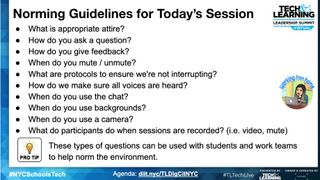With schools moving classes online, a lot of new challenges have arisen as educators engage with their students through a screen. One of the first challenges that has emerged as a result is the ease with which students can record what teachers say during video calls and then manipulate the images or recording and post it online.
During Tech & Learning’s recent Virtual Leadership Summit, a talented group of educators from the New York City Department of Education--including Lisa Nielsen, Laura Ogando, and Jackie Patanio--led an engaging discussion about teaching digital citizenship to students. I was honored to attend and would like to share some thoughts.
See the entire discussion
Norming Guidelines
One thing reiterated by the panel throughout the presentation was the idea that teachers need to share norms about how to interact and expectations for online behavior, especially at the beginning of the year.
Some guidelines to consider and discuss with your students:
- When is it appropriate to turn your camera on or off?
- Please limit private chat.
- Mute your mic when you’re not talking.
- Check your background and the items/people behind you.
These may seem fairly simple but each one has a lot of impact when it comes to student privacy laws. Now that teachers have a window into the homes of their students, there is also an added pressure to report things that they might see happening in the background, which adds additional pressure.
Here’s a full list of questions for teachers to consider addressing with their students.

Personalizing Remote Learning
It’s hard to gauge your audience when they are online. Even if their cameras are on, it’s impossible to hear all your students when the entire class is off mute. Teachers need to create strategies to engage their students but also get to know them without the benefits of being in-person.
Holding one-on-one and small group virtual discussions can help with that. Some schools mentioned having virtual “meet the teacher” sessions planned for the beginning of the year so that teachers can get to know their students better.
One idea that has gained steam over the past few months is the idea of a “BitMoji Classroom.” The premise is teachers create a mock classroom using presentation software such as Google Slides. Then students can click on different parts of the classroom that will guide them to the classroom rules, about the teacher, etc. In many ways, it’s a simpler way to make an interactive website, only with the clever BitMoji versions of the teacher. The presenters even created a slide in their presentation that represented this:

While I agree that it personalizes the experience, I would also encourage teachers to share their actual face with students to help build those relationships. Otherwise, they might just think their teacher is a cartoon.
Consequences for Later Life
One of the bigger hot-button issues that came up during the conversation was at which point do students’ actions online impact their future life? Recently, we’ve seen a rise in celebrities and politicians being called out for comments or feelings posted online or during an interview, but at what age should students be held in the same regard?
The group was somewhat split in their responses but the majority felt that around the same time a student is allowed to drive a car is when they need to be a little more serious about their digital footprint. Posting funny TikTok videos and SnapChats are part of the exploratory nature of tweens and teens and shouldn’t be held against them. Intent is still the primary driver of whether or not there should be harsh consequences levied by schools or the public.
Setting the Routine
Teachers can’t control what is being said or encouraged at home. They can, however, control what they do and say with their students.
While norms and strategies are important, the panel emphasized that teachers need to make sure that routines and expectations are continual and redundant. Both teachers and students are experiencing this new experiment in remote learning at the same time. Creating those routines continue to be an important component of the classroom, whether it be in-person or remote. The emphasis on digital citizenship is now much more critical as learning moves online.

